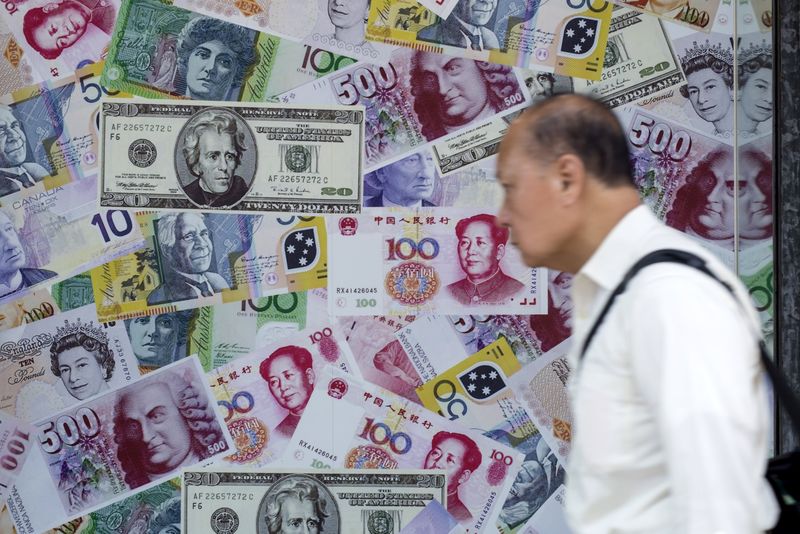By Sujata Rao and Dhara Ranasinghe
LONDON (Reuters) - Demand for long-dated bonds and the extra yield they offer has boomed over the past decade in an era of ultra-low interest rates. Yet now, even as central banks tighten policy, investors show little sign of retreating from the riskier debt.
Portugal last week sold 315 million euros ($365 million) of 28-year bonds at yields well below secondary market rates - indicative of strong demand - while Argentina sold $2.75 billion of a 100-year bond last month.
Britain drew record demand from investors at a 40-year gilt sale in May, while the United States is considering issuing ultra-long debt of beyond 30 years for the first time.
Such bullish interest in the longer bonds, which offer both higher risks and returns than shorter debt, appears counter-intuitive at present.
Major central banks, including the U.S. Federal Reserve and the European Central Bank, are looking to end the stimulus programs that have seen them buy up huge quantities of long bonds, and also to raise interest rates - thus undermining big draws for the so-called duration trade.
The reason for the persistently robust demand for long debt, according to some investors, is because inflation - which erodes the value of bonds, with longer dated hardest hit - remains below target in the United States and euro zone.
President Donald Trump's promise of a multi-trillion-dollar spending programs, which had fueled expectations of global "Trumpflation", has failed to materialize amid political deadlock in Washington.
Oil prices, a key driver of inflation, also remain weak.
Duration trades in the long term will also continue to draw support from what fixed-income industry experts describe as a "new paradigm" - where the possibility of structurally low inflation, and a burgeoning pension industry due to an aging Western population, supports demand for long-dated securities.
Jan von Gerich, chief strategist at Nordea bank, reckons average bond duration will continue to rise, noting the impressive demand for long debt at auctions.
"An increasing amount of investors are venturing out further along the curve," von Gerich said. "A swing in bond yields would hurt this but that's likely to be a temporary step back more than anything else at the moment."
Duration is a measure of how long it takes to recoup the original investment in a bond. While it is expressed in years, duration is usually different from the bond's tenor and is a useful gauge to compare debt with different maturities and coupons.
It helps explain why serial defaulter Argentina was able to place a century bond, drawing huge interest. The bond's 7.125 percent coupon means most of the cash flow will come from interest payments, rather than the principal which will be repaid 100 years later.
By that measure, buyers of the Argentine bond will recoup their outlay after just 13 years, investors calculated. That makes the bond attractive compared with Argentina's existing 30-year issue which repays investors after 12 years.
HAWK TALK
For years, longer-dated bonds have been in demand as investors scrambled for the extra yield they provide - Merrill Lynch's index of G7 debt with maturities of over 10 years has returned over 10 percent in the past two years versus 1.4 percent gains for its index for 1-5 year bonds .
Central bank comments over the past three weeks have fanned a view that monetary policy in major economies is at a turning point after years of remaining ultra-loose to shore up growth and inflation in the wake of the financial crisis.
ECB chief Mario Draghi highlighted a recovering euro zone economy in comments that were seen opening the door to policy tweaks, while Bank of England Governor Mark Carney said his central bank was likely to debate a rate rise in coming months.
The Bank of Canada, meanwhile, hiked rates last week for the first time in almost seven years.
This hawkish central bank talk and action seemed to have had only a temporary impact on longer-dated bonds.
Over the past three weeks, the Merrill Lynch long bond index lost as much 2.5 percent in the at period but has recovered more than a quarter of those losses, and now appears to be back on an upward trajectory.
"On one hand you have got central banks telling you they want to ease back on purchases and they have been the largest buyers on that part of the curve," says Hinesh Patel, portfolio manager in the multi-asset team at Old Mutual Global Investments.
"But for the longer term, I really like long duration."
NEW PARADIGM
Patel argues Fed rate rises are likely to further flatten the Treasury yield curve as they did during previous tightening episodes in 1994 and early-2000s. That's because higher interest rates may raise short-dated yields while tame inflation means yields on longer maturities stay stable or fall further.
Expectations of subdued inflation in the long term means investors are likely to prefer to put money into longer-dated bonds which offer better returns.
"In the context of a curve flattening strategy, you would favor longer-dated bonds compared to intermediate maturities," said Mark Dowding, a portfolio manager at BlueBay Asset Management.
Duration bulls received more encouragement from Fed Chair Janet Yellen who told Congress last week rates may not rise "all that much further" while ECB officials have stressed adjustments would be introduced "carefully and flexibly".
The world's largest asset manager BlackRock reckons historically low yields are here to stay. It expects the premium on long-dated bonds over shorter maturities will rise with interest rates in major economies, but very gradually and eventually suppressed by demand for safe securities.
"I don't buy into long rates moving back to the 4 percent territory," Patel said. "If you look at traditional economics, wage growth ... you can see we are in a new totally different dynamic - so basically, lower for ever."
Graphic on long-term demand: http://reut.rs/2u52PWO
